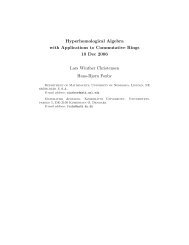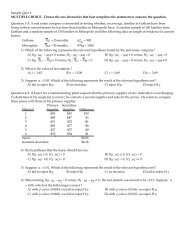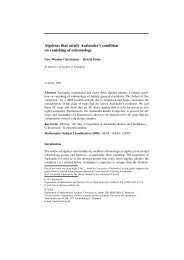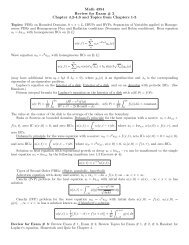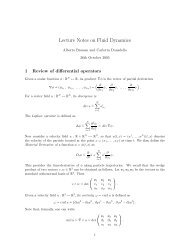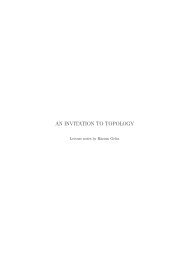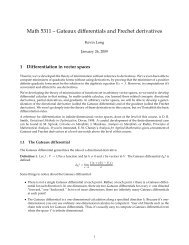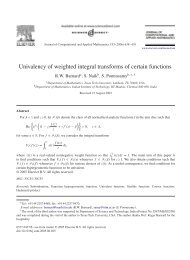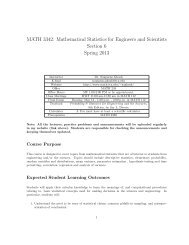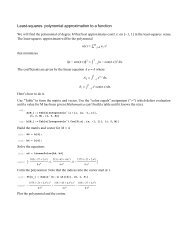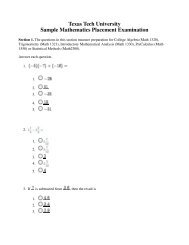QUANTUM MECHANICS AND NON-ABELIAN THETA FUNCTIONS ...
QUANTUM MECHANICS AND NON-ABELIAN THETA FUNCTIONS ...
QUANTUM MECHANICS AND NON-ABELIAN THETA FUNCTIONS ...
Create successful ePaper yourself
Turn your PDF publications into a flip-book with our unique Google optimized e-Paper software.
36RĂZVAN GELCA <strong>AND</strong> ALEJ<strong>AND</strong>RO URIBEorthonormal basis of the Hilbert space isζ τ j (z) = 4√ r(θ τ j (z) − θ τ −j(z)), j = 1,2,... ,r − 1,where θ τ j (z) are the theta series from Section 3.1. The definition of ζτ j (z)should be extended to all indices by the conditions ζ τ j+2r (z) = ζτ j (z), ζτ 0 (z) =0, and ζ τ r−j (z) = −ζτ r+j (z).Let us turn our attention to the Weyl quantization of Wilson lines. If pand q are coprime integers, then the Wilson line for the curve with slopep/q on the torus and for the 2-dimensional irreducible representation is justW p/q (x,y) = f(x,y) =sin4π(px + qy)= 2cos 2π(px + qy),sin2π(px + qy)when viewing the pillow case as a quotient of the plane. This is becausethe character of the 2-dimensional irreducible representation is sin2x/sin x.Moreover, if p and q are arbitrary integers, the function f(x,y) = 2cos 2π(px+qy) is a linear combination of Wilson lines. Indeed, if n = gcd(p,q), p = np ′ ,q = nq ′ , then2cos 2π(px + qy) = sin[2π(n + 1)(p′ x + q ′ y)]sin2π(p ′ x + q ′ y)− sin[2π(n − 1)(p′ x + q ′ y)]sin 2π(p ′ x + q ′ ,y)so 2cos 2π(px+qy) = W γ,n+1 −W γ,n−1 where γ is the curve of slope p ′ /q ′ onthe torus. This formula also shows that Wilson lines are linear combinationsof cosines, so it suffices to understand the quantization of the cosines.Because the pillow case is the quotient of the torus by the antipodalmap, the Weyl quantization on the pillow case can be obtained by doingequivariant Weyl quantiztion on the torus. Moreover, since2cos 2π(px + qy) = e 2πi(px+qy) + e −2πi(px+qy) ,we find that the Weyl quantization of the Wilson lines can be obtained byextending linearly the Schrödinger representation to the group ring of thefinite torus, restricting it to the subring invariant under the map exp P →exp(−P) and exp Q → exp(−Q), and then letting it act on odd theta functions.For the quantization of the cosines ( we obtain the formula)op(2cos 2π(px + qy))ζj τ πi(z) = e− 2r pq e πir qj ζj−p τ πi(z) + e− r qj ζj+p τ (z) .In particular the ζj τ ’s are the eigenvectors of op(2cos 2πy), correspondingto the holonomy along the curve which cuts the torus into an annulus. Thisshows that they are correctly identified as the analogues of the theta series.5.2. The quantum group quantization of the moduli space of flatSU(2)-connections on the torus. The quantum group quantization ofM 1 is the particular case of the construction performed in Section 4.2. Setagain = 1 2r. The Hilbert space has an orthonormal basis consisting of ther − 1 vectors V 1 (α),V 2 (α),... ,V r−1 (α), obtained by coloring the core α ofthe torus by the irreducible representations V 1 ,V 2 ,... ,V r−1 of U (sl(2, C))(see Figure 17). These are the quantum group analogues of the ζj τ’s.



